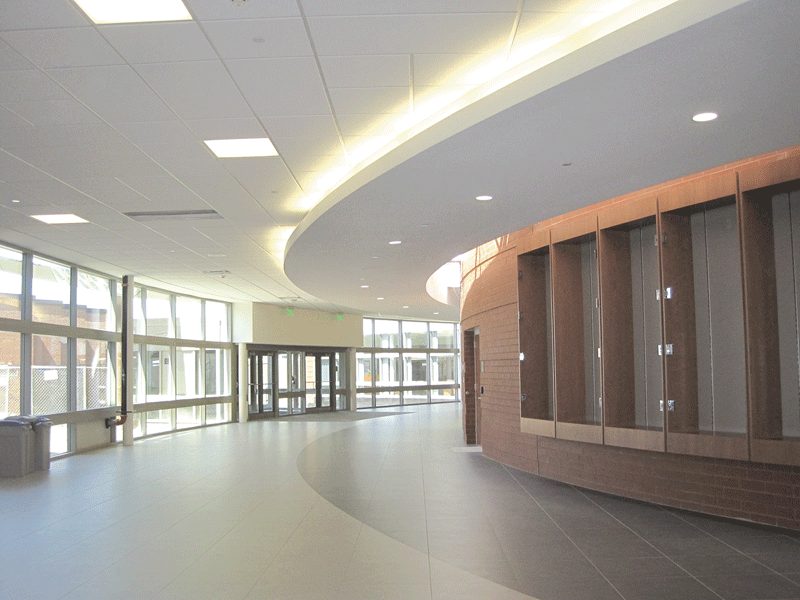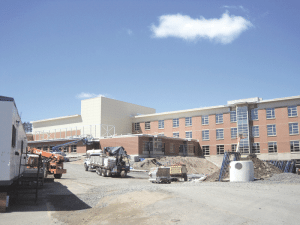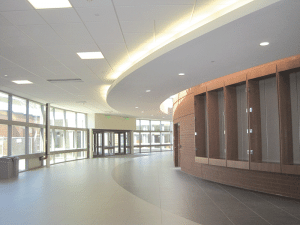
Lessons Learned
Schools Say Green Construction Benefits Students, Teachers

The new West Springfield High School is expected to be certified as a LEED Silver building when it’s completed.
While businesses of all kinds are increasingly calling for more environmentally friendly, energy-efficient building designs — with many seeking certification from Leadership in Energy and Environmental Design (LEED), a rigorous program of the U.S. Green Building Council — in many ways the education sector has been leading the way.
And, according to a report recently issued by McGraw-Hill Construction titled “New and Retrofit Green Schools: The Cost Benefits and Influence of a Green School on Its Occupants,” schools of all levels — elementary, middle, and high — as well as universities, report significant benefits from studying and working in green buildings — advantages that extend well beyond economics.
It’s an area ripe for study; McGraw-Hill characterizes the education-construction market to be at the “vanguard” of green building, estimating that 45% of total construction starts in the education sector in 2012 had green components — a sharp increase from 15%
in 2008. “And that estimate,” the authors note, “does not even include the full scope of work being done to green existing buildings through retrofits and green operations and maintenance.”
In Western Mass., the trend is pervasive. Many recent and ongoing high-school projects in the region — including new buildings for Easthampton High School, West Springfield High School, Longmeadow High School, and Minnechaug Regional High School, to name a few — feature significant green aspects, from photovoltaic energy production to extensive natural light to a building materials relatively free of toxins and respiratory irritants.
“What is driving this market?” the report asks. “Like
all other sectors, schools are driven by
the goal of saving money and energy. However, this sector is unique among all those studied by McGraw-Hill construction … because the impact of green buildings on the health and well-being of their students is as important as energy in encouraging new green investments. In fact, the level of green work is so high in this sector because many report seeing the financial, health and well-being, and productivity benefits that they seek.”
Additionally, 70% of K-12 schools and 63% of universities report that student tests scores increased in the wake of green construction. Employees are happier, too, as 83% of K-12 schools and 85% of university leaders report increased faculty satisfaction as a result of teaching in a green building.
Whatever the metric, there appears to be growing evidence that green building design is more than a fad in the educational world, but a trend with real long-term benefits.
Cost and Effect
When deciding to go green at their facilities, many businesses look first at the cost, and that’s no different for municipalities or colleges looking to erect school buildings. And a 2006 study conducted by Capital E, a national clean-energy and green-building firm, argues strongly for the fiscal benefits of such construction.
Its cross-country review of 30 green schools demonstrates that green schools cost less than 2% more to build than conventional schools — or about $3 per square
foot — but provide financial benefits that are 20 times as large. In fact, the report argues, that extra $3 pays off in $71 worth of ancillary financial benefits, from energy and water savings to asthma and flu reduction, to decreased absenteeism and greater teacher retention.
“Greening school design,” notes Gregory Kats, managing principal of Capital E, “provides an extraordinarily cost-effective way to enhance student learning, reduce health and operational costs, and, ultimately, increase school quality and competitiveness.”
He concedes that his report — co-sponsored by the American Federation of Teachers, the American Institute of Architects, the American Lung Assoc., the Federation of American Scientists, and the U.S. Green Building Council — doesn’t quantify every possible benefit of green buildings, including reduced teacher sick days, reduced maintenance costs, reduced insured and uninsured risks, increased state competitiveness, and others.
The recent McGraw-Hill study isn’t all-encompassing, either, but it does delve deeply into the question of how significantly a school designed to reduce its environmental impact on the world
can affect the health and learning abilities of its students, in ways ranging from reducing respiratory illnesses
and absenteeism to improving test scores.
“Given the complexity of interactions between people and their environments, establishing cause-and-effect relationships between an attribute of a green school and its occupants has been a challenge,” the report notes. But it does detail several possible benefits of a greener environment, including:
• Indoor air. Plenty of research exists to demonstrate that the health of children and adults can be affected by indoor air quality, and that increased particulate matter, volatile organic compounds (VOCs), toxins, irritants, and allergens from mold can lead to respiratory illnesses and asthma.
On the other hand, good indoor air quality is typically marked by effective ventilation, filter efficiency, temperature and humidity control, and stricter operations, maintenance, and cleaning practices. For instance, in a 2002 study in Finland, researchers identified an average 15% reduction in the incidence of the common cold in schools that had no moisture or
mold problems. And according to researchers at Lawrence Berkely National Laboratories, when ventilation rates drop below minimum standards, student performance test results drop by 5% to 10%.
“Good ventilation is the most impactful way to protect lung health in a green school, but reducing and preventing the source of indoor air pollutants is another key area,” notes Janice Nolen, assistant vice president of National Policy and Advocacy for the American Lung Assoc., in the McGraw-Hill report.
“Indoor air pollution such as particulate matter, volatile organic compounds, and irritants can originate from various sources indoors, such as building equipment, furnishings, flooring, and cleaning equipment,” she continues. “For example, it is important not to use cleaning supplies within schools that are going to cause irritations and breathing problems such asthma or chronic lung diseases.”
• Lighting. As recently as the 1970s and even the 1980s, the report notes, conventional wisdom held that lack of daylight, while irksome to some students, had no discernible impact on test scores. But since then, studies have shown that daylight can affect student health and learning.
Indeed, 48% of K-12 survey respondents and 56% of university leaders said increased access to natural light and outside views from their classrooms increased student engagement. Among other studies, one conducted by the Heschong Mahone Group in 1999 showed that students in classrooms well-lit by natural sunlight had 7% to 26% higher test scores over the course
of a year, compared with students in windowless classrooms.
• Thermal comfort. Recent research, McGraw-Hill notes, has begun questioning the prevailing thinking that keeping indoor temperature within a narrow band — typically the low to mid-70s — year-round is ideal. One recent study showed that student speed on a standardized test increased as a result of lowering the temperature from 77 to 68 degrees. Meanwhile, research conducted from the 1990s and onward suggest that teachers have a strong preference for personal control over temperature and see it as having an impact on student performance.
• Acoustics. Significant research has been undertaken to study how classroom design impacts the ability of students to hear, pay attention, and absorb information. Outdoor noise can be a negative factor as well; a recent study shows that students in a school under the regular flight path of an airport performed up to 20% lower on a reading test than children in a nearby school.
McGraw-Hill also cites research suggesting that a room’s acoustic and sound-insulation properties have a direct effect on speech intelligibility and, consequently, student learning. Of its survey respondents, 44% of K-12 schools and 51% of university leaders who included improved acoustics in their green projects reported better student attentiveness as a result.
Crunching the Numbers
According to the study, 74% of green K-12 schools are attempting to measure the impact of the building design on student health, but only 47% in higher education are doing the same. That might be because K-12 schools can more easily track metrics such as absenteeism, asthma complaints, and visits to the school nurse. Meanwhile, colleges and universities are more likely to glean data from student and staff surveys.
Of the K-12 respondents, 32% of schools said their green-building efforts have reduced absenteeism, while just 2% found an increase; 67% reported no change. However, of the participating schools that achieved the stricter LEED certification, 45% reported decreased absenteeism, and 44% of the buildings that received an Energy Star label reported the same.
The study noted that the connections between green building design and student health and performance are still being developed and aren’t nearly as clear as those that compare physical activity and health. “Studies show that 15% of school-age children are overweight, and this number is three times higher than it was in the late 1970s,” the report notes. “Unfortunately, there is insufficient data to attribute success to any particular solution that relates to school buildings.”
At the same time, McGraw-Hill notes that much more data is necessary to fill in the gaps and presumptions that have arisen around environmentally friendly construction. For example:
• More research is needed into the lack of adequate ventilation in America’s classrooms, even though the codes and practices of the HVAC industry have been around for a long time. More information is needed on how HVAC system designs and maintenance procedures impact air quality. Also, more research is necessary on how materials selection, such as those that include VOCs, affect student health and learning.
• There is a need for more performance-based design guidelines that can reliably produce excellent visual environments in terms of natural light. And, as an emerging technology now making its way into school buildings, light-emitting diodes, otherwise known as LED lights, warrant more intensive research.
• As new technology is developed and low-energy heating and cooling methods become prevalent in high-performance buildings, their potential impacts on student health and well-being need to be researched. At the same time, more information is needed concerning the ideal temperature in a classroom and what level of teacher control is warranted.
• Finally, more information is needed on the factors that go into the acoustic performance of a classroom, and how best to provide for the needs of hearing-impaired children in classrooms.
Still, the education world — and the architecture and construction industries — are taking notice. “Building healthy, high-performance school buildings is now far more fiscally prudent and lower-risk than building conventional, inefficient, and unhealthy school buildings,” Kats argues.
There are educational benefits as well, says Darryl Alexander, health and safety director of the American Federation of Teachers, in the McGraw-Hill report.
“We’ve heard from teachers that green schools have been useful as learning tools and allowed them to incorporate sustainability into the curriculum — teaching them, for example, how to measure and track energy use,” he notes. “Green roofs have allowed them to explain benefits such as reduced energy use, greenhouse gas emissions, and reduced stormwater runoff.”
But perhaps the most significant benefit is healthier — and more focused — children and young adults.
“Teachers, whether they know much about green schools or not, once they enter one of these buildings, they are excited because these schools are quite different from conventional school buildings,” Alexander says. “The natural lighting, the acoustics, the air quality and comfort really allow them to focus on their jobs more easily. It is amazing to watch.”
— Joseph Bednar






